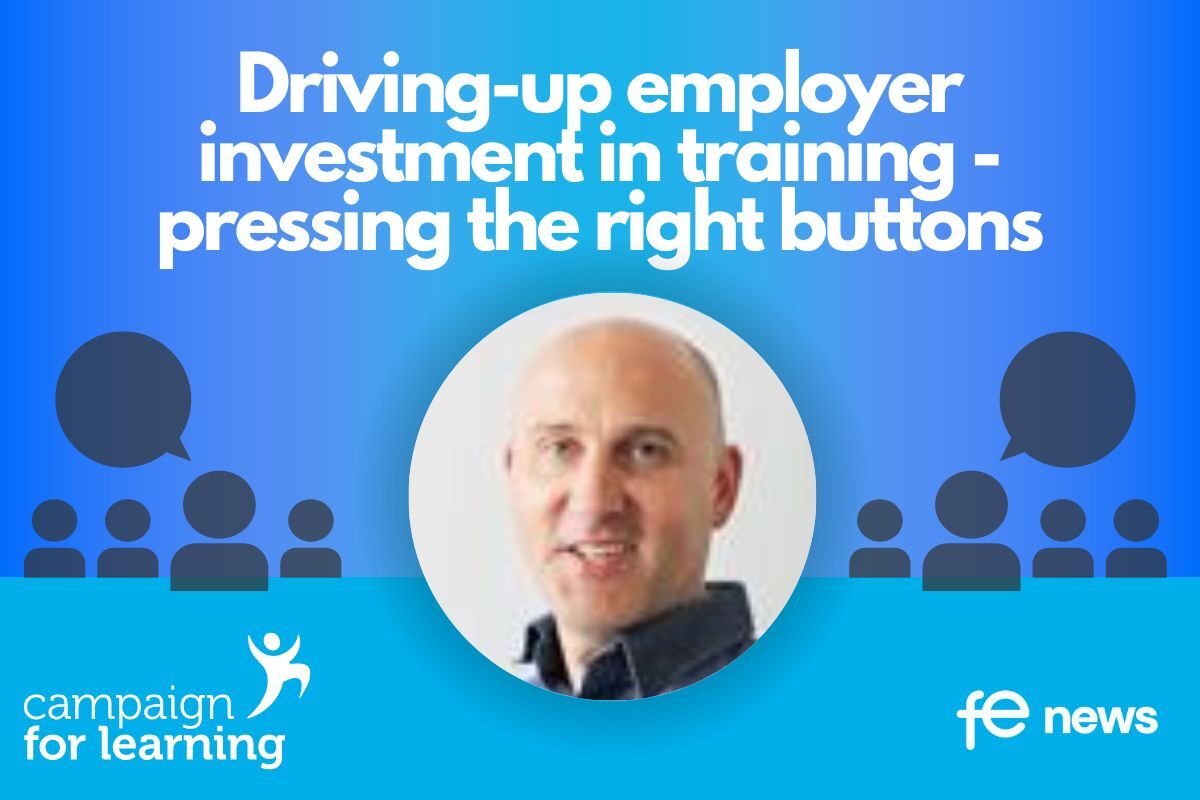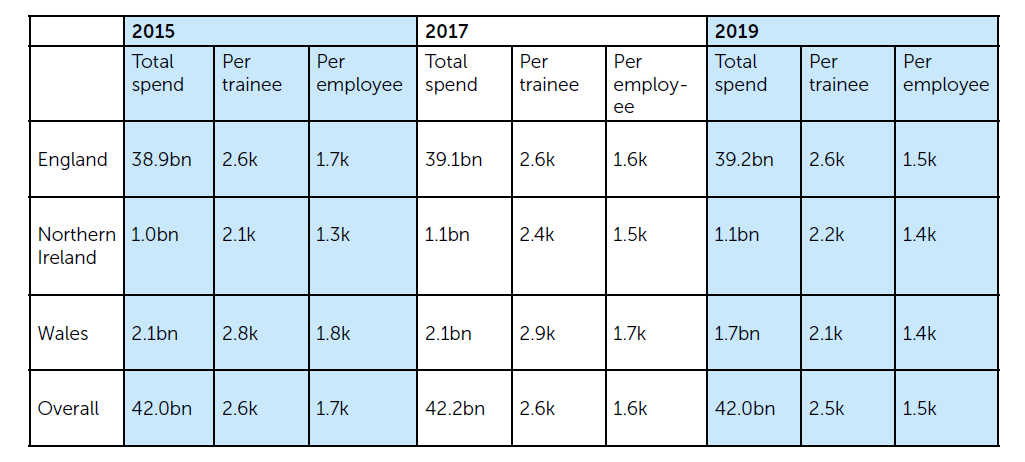Job quality, job design and driving-up employer investment in training

Evidence shows that employer investment in training in England remained stable in real terms between 2015 and 2019 (see Table 1). But there was a 9% fall in spending on training per employee in real terms from £1.7K in 2015 to £1.5K in 2019, and the average number of training days per trainee in England has fallen from 6.8 in 2015 to 6.0 in 2019.
Table 1: Employer investment in training

Note: Scotland is covered by the separate Scottish Employer Skills Survey; NESS 2019
Employer investment in training is unequal, both across and within businesses. Smaller businesses and employers in lower wage, lower productivity sectors – such as retail and hospitality – are less likely to invest in training. In comparison, higher value and more knowledge intensive sectors are more likely to invest in training (Clayton N and Evans S, 2021, Learning at Work: Employer Investment in Skills. Learning and Work Institute).
Where employers do not invest in training, the most common reason given is that they believe there is no need for it. For those that do provide training, the most cited barrier is not being able to spare staff time and lack of funds.
Low-cost business models
The reasons behind the overall decline in some of the metrics for employer investment in training are unclear. Various explanations have been proposed including a lack of need due to increased numbers of graduates, increased efficiency in training, and less optimistically employers adopting ‘low-road’ competitive strategies based around low cost and which require lower levels of skills (CIPD 2019, Addressing employer underinvestment in training: The case for a broader training levy).
This last explanation has some evidence to support it with an observed reduction in the time taken to be proficient in role. That said, there is also anecdotal evidence of employers investing in skills despite adopting a low-cost business model in typically low-investment sectors (Anderton E, Bevan S, 2014 Constrained work? Job enrichment and employee engagement in low wage, low skill jobs. Work Foundation. Academy of Management Annals, Vol 11, No.1).
Misalignment between business strategy and human capital strategy
There are, therefore, examples of misalignment between business strategy and underlying human capital strategy (Parker S, Van den Broeck A, Holman D (2017) Work Design Influences: A synthesis of multi-level factors that influence the design of work). Research has explored the evidence for various factors impacting on these choices, including job quality and job design.
Job quality, job design and employer investment in training
The construct of job quality is typically assessed using a range of indicators. The Measuring Job Quality Working group (Measuring Good Quality Work: The final report of the Measuring Job Quality Working Group, 2018, Carnegie Trust. RSA), formed in response to the Good Work Plan, identified seven dimensions comprising the quality of work:
- Terms of employment;
- Pay and benefits;
- Health, safety and psychological well-being;
- Job design and nature of work;
- Social support and cohesion;
- Voice and representation,
- Work-life balance.
Recent analysis by the ONS2 assessed the current picture with respect to job quality in the UK analysing selected indicators by region, industry, and demographic and occupational characteristics (Office for National Statistics, 2002, Job Quality in the UK: Analysis of Job Quality Indicators: 2021. ONS). To take one of the indicators as an example that is relevant to skills, men working full-time in knowledge-intensive industries in London were most likely to report positive perceptions of career progression opportunities. The Chartered Institute for Personnel Development’s (CIPD) Good Work Index concluded similarly, finding a consistent pattern of better job quality among higher-level occupations and being generally lower in lower-level occupations (CIPD, 2022, Good Work Index 2022 – UK Working Lives Survey. 2022).
Effective job or work design has the potential to impact multiple aspects of job quality. Job or work design can be defined as “the content and organization of one’s work tasks, activities, relationships, and responsibilities”.
Essentially, all organisations face the challenge of how to divide and allocate the work that needs to be done, and then to integrate those efforts through coordination and cooperation. There are multiple solutions to this essential problem of organising, and the choices made have implications for job quality including skills needs.
There is considerable evidence that effective job or work design has benefits both for the individual and the organisation (Parker S, Van den Broeck A, Holman D, 2017, Work Design Influences: A synthesis of multi-level factors that influence the design of work).
The core idea is that job or work designs that are deleterious to the individual worker, which are typically Taylorist in nature and involve little worker control over how tasks are done, are not inevitable or even desirable, even in low-cost business models or typically low paying sectors (Ton Z, 2014, The Good Jobs Strategy. MIT Sloan School of Management). More preferable are work or job designs which offer worker autonomy, social support, and that avoid an imbalance of demands and resources (resources includes skills, supervisor and peer support).
A review of research exploring the question ‘Where do work or job designs come from?’ concluded that whilst there is evidence for the impact of external factors on job design, proximal factors such as managerial decisions play a significant role (Parker S, Van den Broeck A, Holman D (2017) Work Design Influences: A synthesis of multi-level factors that influence the design of work).
The research identifies examples of high involvement HR strategies incorporating investment in training in low-cost business models. There is also the unresolved question of whether greater investment in skills can, as it were, force greater adoption of more enlightened approaches to work design and hence higher job quality through either employees’ crafting their own jobs or managers having greater trust in the competence of their staff and willingness to delegate more complex tasks.
Recommendation 1
The Government and wider stakeholders should continue to pilot interventions in improving work design and job quality, develop the evidence base and, importantly, spread good examples of improving work design and job quality.
Recommendation 2
The Government should continue and enhance efforts to encourage investment in skills development, including managerial competence and capability.
Recommendation 3
The Government should target job quality and job design strategies alongside strategies to increase employer investment in skills development – including management training – on enterprises in low wage, low skill sectors.
By Dan Lucy, Director of HR, IES
This article is part of Campaign for Learning’s series: ‘Driving-up employer investment in training – pressing the right buttons’.
Part One: Employer investment in context
- Louise Murphy, Economist, Resolution Foundation: Investment in the round
- Dr Vicki Belt, Deputy Director, Enterprise Research Centre, Warwick Business School: UK enterprises and investment in capital and training
- Becci Newton, Director, Public Policy Research, Institute of Employment Studies: Employer investment in training in England
Part Two: Drivers of employer investment in training
- Neil Carberry, Chief Executive, Recruitment and Employment Confederation: Derived demand, British management and employer investment in training
- Ewart Keep, Professor Emeritus, Education Department, University of Oxford: Strategies to drive-up employer investment in training
- Sam Alvis, Head of Economy, Green Alliance: Transitioning to net zero, green skills and employer investment in training
- Dan Lucy, Director of HR, Institute of Employment Studies: Job quality, job design and driving-up employer investment in training
- Natasha Waller, Policy Manager, LEP Network: Local inward investment, business support and employer demand for training
- Jovan Luzajic, Acting Assistant Director of Policy, Universities UK: Universities, R&D, business innovation and meeting employer skills needs
- David Hughes, Chief Executive, Association of Colleges: FE colleges, business innovation and meeting employer skills needs
Part Three: Increasing employer investment in training
- Paul Bivand, Labour Market Consultant: Why should employers invest in training in a flexible labour market?
- Aidan Relf, Skills Consultant: Why should employers invest in training with large net worker migration into the UK?
- Stephen Evans, Chief Executive, Learning and Work Institute: Raising employer investment in training
- Robert West, Head of Education and Skills, CBI: Increasing employer investment in training
- Lizzie Crowley, Skills Policy Adviser, CIPD: Encouraging employer demand for training
- Anthony Painter, Director and Daisy Hooper, Head of Policy and Innovation Chartered Management Institute: Increasing employer demand for management training
Part Four: Raising employer demand for publicly funded post-16 education and skills
- Jane Hickie, Chief Executive, AELP: Increasing employer demand for post-16 apprenticeships in England
- Mandy Crawford-Lee, Chief Executive, UVAC: Increasing employer demand for level 4-5 technical education in England
- Ian Pryce, Principal, The Bedford College Group: Increasing employer demand for higher technical education in England
Part Five: Raising employer demand for work placements
- John Widdowson, Board Member, NCG: Increasing employer demand for work placements for level 3-5 vocational courses in England
- Stephen Isherwood, Joint Chief Executive, Institute of Student Employers: Increasing employer demand for undergraduate work placements in England











Responses